![Using [Sic] Properly: Everything You Need to Know](https://cdn.rawisda.com/news/6c/33/40/6c3340d8ae42d35d4950e0be8631a5ae-b.jpg)
views
- Include the word "sic" in brackets immediately after a misspelling or grammatical error that appears in the original source you are quoting.
- "Sic" is a Latin word meaning "thus" or "so." In quoted text, it means that the writer has written the quote exactly as it appears in the original source.
- Paraphrase text or explain the errors outside of the quote if you don't want to use "sic" or if your stylebook advises against using "sic."
What does "sic" mean?

"Sic" is a Latin word meaning "thus" or "so." When "sic" appears in quoted text, it's meant to inform the reader that the writer copied the quoted text verbatim from the original source. This is typically necessary when a misspelling, grammatical error, or other error appears in the original source. "Sic" is more common in formal writing, such as journalism and academic writing, where it's considered unethical to alter quoted text in any way. In the Scottish language, the word "sic" is used to mean "such." The word "sic" is also used in casual English as a verb and refers to attacking someone or something, or enticing someone or something to attack. For example, you might say "sic 'em" to a guard dog or attack dog to get the dog to respond to a threat. You might have heard that the word "sic" is an acronym for something like "said in context" or "spelling is correct." These are considered "backronyms" because they were made up after the word itself already existed, and they're not accurate—but feel free to hang on to them if they help you remember what "sic" means!
Using [Sic] with Quotes
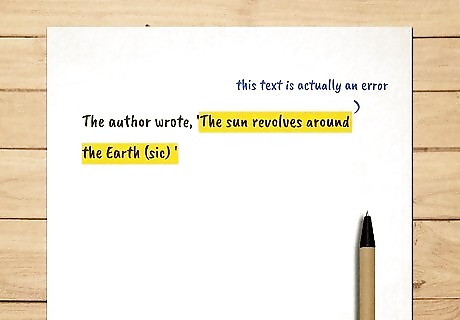
Make sure the text is actually an error. Just because you haven't seen a word or phrase before doesn't mean it's wrong. If a word is spelled in an unusual way, look the word up to see if there are any alternative spellings. To check for grammatical errors, you can try searching the internet for the particular phrase to see if it's used in other places or contexts. Remember that British English and American English use different spellings of some words (such as "flavour" and "flavor"), and most of the English-speaking world uses the British spellings. If your original source is written in British English, use British English for quotes. "Sic" would be inappropriate in this instance because the quoted material isn't wrong. There's also a possibility that the author of the original source is using poetic license to intentionally misspell a word or mess around with grammar. In those situations, you typically wouldn't use "sic" either.

Type brackets around the word "sic." Typically, the word "sic" is surrounded by square brackets within the quoted text. This indicates to your reader that the word "sic" was added by the writer and did not appear in the original source material. For example, if you're quoting a source that uses the wrong verb form, you might write, "Smith noted that 'dog are [sic] cool.'" Some stylebooks would have you use parentheses rather than square brackets, although square brackets are much more common. Check your stylebook! However, when in doubt, square brackets are the way to go.

Style "sic" in italics if required by your stylebook. Some stylebooks require all Latin words and abbreviations to be in italic, but not all of them do. Some stylebooks, while requiring Latin words to be italicized generally, make exceptions for commonly used words such as "sic." There's no hard and fast rule about this. For example, if you're quoting a source with a spelling error, you might write, "Logan emphasized that 'painting can be a great way to del [sic] with mental health problems.'" Generally speaking, if you fail to italicize "sic," it probably won't make a whole lot of difference. Your readers will certainly still understand the purpose of it.
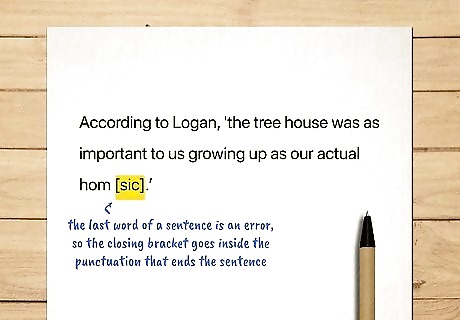
Place "sic" immediately after the error. Type a single space, then follow the error with "sic" so that your readers know what error you're pointing out. If you were to put it at the end of the quote, your readers wouldn't know specifically which replicated error you were referring to. If the last word of a sentence is an error, the closing bracket goes inside the punctuation that ends the sentence. For example, you might write, "According to Logan, 'the tree house was as important to us growing up as our actual hom [sic].'" Likewise, if the error is followed by any other punctuation mark (such as a comma or semi-colon), that punctuation mark goes after the closing bracket for "sic."
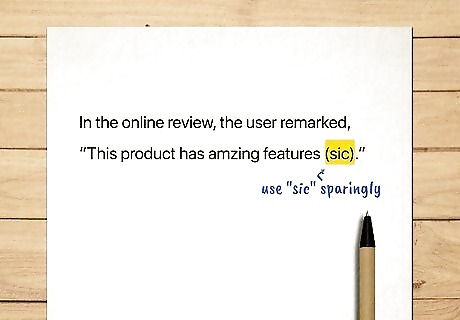
Use "sic" sparingly and only when there's no good alternative. Using "sic" means drawing attention to an error in the original source. Many people think this comes across as snobby or elitist. To avoid that impression, it's usually best to save "sic" for times when it's absolutely necessary to avoid confusion on the part of the reader. It's also true that people are often more likely to use "sic" after any and every error when quoting someone they dislike or disagree with. When you do this, it makes it seem as though you're making fun of the person you're quoting.
Alternatives to [Sic]
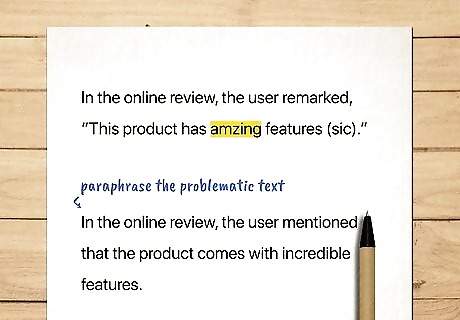
Paraphrase the problematic text rather than quote it word by word. If the person's exact words aren't necessary for what you're writing, a simple paraphrase can sometimes work better than a quote that needs "sic." This is especially true if you're quoting a relatively short passage with several errors. In some situations paraphrasing won't work. For example, if you're writing a legal document, it's likely that the exact wording has legal significance. In that case, you would use "sic" after every error.

Acknowledge the quote is verbatim when introducing it. Rather than littering a quote with "sic" multiple times, you could simply tell your readers that you've reproduced the quote with errors intact. This tactic works best if you're quoting casual writing, such as a social media post, that happens to have numerous errors. For example, you might write, "For better readability, this quote is presented verbatim despite numerous errors." You could also simply reproduce the text verbatim and explain the errors outside of the quotation. For example, you might write, "'Girafes are my favorite animal at the zoo,' the child wrote, even though they could not yet spell the name of the animal."

Correct the error and put the corrected text in brackets. Some stylebooks do allow you to make basic grammar and spelling corrections to quoted text as long as you use square brackets to signify the change. That way, if a reader goes back to the original text, they can clearly see what you changed. For example, if the quote reads, "I definately want to see that movie in the theater," you might write, "I [definitely] want to see that movie in the theater."

Use the Latin word "recte" instead. "Recte" means "rightly" in Latin. Use this the same as you would "sic," in square brackets immediately following the error. After you type "Recte," type the correct word or phrase, then close your brackets. For example, you might write, "There is general concensus [Recte consensus] that climate change is real." This might seem a bit stiff, but if you're writing something that is strictly formal, such as a piece for an academic journal, doing so might be required.

Omit the text that contains the error and use an ellipsis. If the word or phrase containing the error isn't strictly necessary for the meaning of the quote, you can always simply leave it out. Just make sure that you aren't altering the meaning of the original source by doing so. For example, you might write, "Scientists believe the... results were skewed because of bias," to correct the sentence, "Scientists believe the strudy results were skewed because of bias." As long as you'd previously indicated that the scientists were talking about a particular study, you could omit the typo without changing the meaning of the quote.

Offer a parenthetical correction. In some situations, it makes sense to gently correct the error, either within or after the quote. This allows your readers to understand that you didn't make the error and also lets them know what was intended. This is especially helpful if the error is really significant and makes it hard to understand what the original source is saying, or if the error actually changes the meaning of what the original source is saying. For example, you might write, "December is the least [read "last"] month of the year," or "December is the least month of the year" (read "last").
Rules with Popular Stylebooks
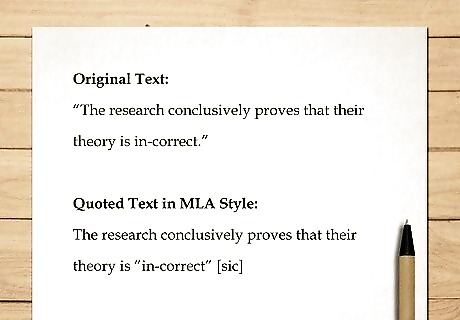
Only use "sic" for errors in MLA style. The MLA stylebook only supports the use of "sic" to mark errors in spelling or grammar that occur in the original text. When used, place it in square brackets immediately after the error. Don't use it for slang or for odd or archaic usage. If it's important for your readers to understand something in a quote that you feel isn't clear, write a sentence after the quote that clarifies the meaning of the quote. Likewise, if the source employs weird formatting, such as typing in all caps or using bold or italics in odd places, copy the quotation exactly as it is. Don't add "sic" to draw attention to formatting or stylistic choices that occur in the original source material.
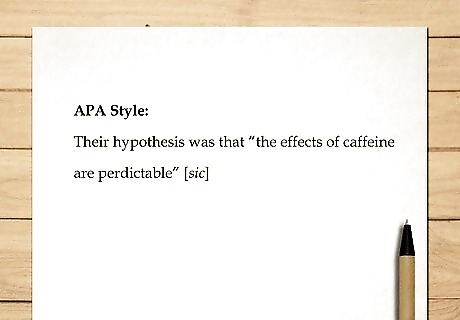
Italicize "sic" and place it in brackets for APA style. APA style requires you to also italicize the word "sic" when it appears in square brackets because it's a Latin word. Use "sic" to mark misspellings and grammatical errors that occur in the original source material. This tells your readers that the typo appears in the source material and wasn't introduced by you. If the error appears in the title of the source material or if there are multiple errors, you might instead consider creating a footnote that explains the mistake to your readers. That way, you don't have to continue using "sic" over and over.

Use italics and brackets for Chicago or Turabian style. Chicago and Turabian advise typing "sic" in italics and enclosing it in square brackets immediately after the error it marks. Make sure you haven't also italicized the square brackets. This indicates to your readers that you've typed exactly what the original author wrote and aren't misquoting anything. With Chicago or Turabian style, you might also use "sic" to point out factual errors, although this is a fairly rare usage of "sic." It's usually better to spend a sentence or two explaining the factual error, either in the main text or in a footnote.

Avoid using "sic" when writing in AP style. The AP stylebook indicates that writers shouldn't use "sic" just to point out an error in grammar, spelling, or usage. Instead, simply type the quote as it appears and leave it at that. If the error is one that you think might confuse readers or give them the wrong impression, add a sentence after the quote explaining it. The bit about adding a clarifying sentence also comes with a caveat. Often, if you feel the need to add a clarifying sentence, it's better simply to paraphrase what was written or said rather than quoting it directly.













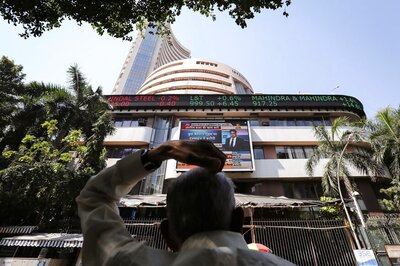

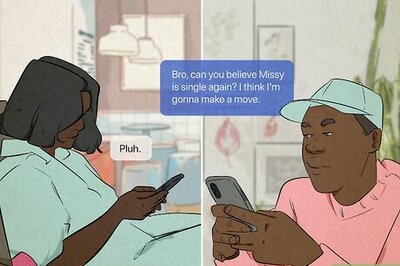
Comments
0 comment